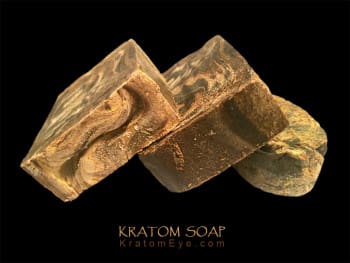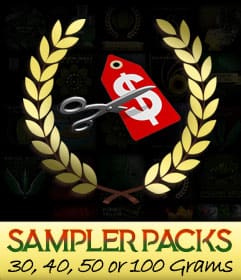Here’s a great recipe to make your own kratom soap from one of our favorite online herb stores: www.MountainRoseHerbs.com. We tweaked their recipe a bit to include our kratom but you can use many herbs and even your own uniquely interesting combinations. Soap alchemy…
Recipe: Kratom (aka Herbal) Soap
This is a simple and recipe enriched with nourishing herbs. Kratom can provide a great exfoliating texture along with antibacterial properties to your soaps. Feel free to experiment with other herbs that you like to use for skin care! This recipe will yield a 2 pound batch of soap which will make approximately 10 bars, depending on how large they’re cut. If you wish to incorporate other ingredients or increase the size of the batch, use a soap making calculator to determine the appropriate amounts of water and lye. These calculators are available online for free. If you wish to add a scent, incorporate ½ – 2 ounces of essential oil when the soap is at trace. The herbs are optional and can be omitted for a pure bar of soap.
Equipment:
- Safety glasses
- Rubber gloves
- Scale
- 2 Thermometers
- Rags and towels for cleaning spills
- White Vinegar for neutralizing lye spills and splashes
- Large Stainless steel pot
- Glass Pyrex or Plastic Pitcher for mixing lye and water
- Wooden, plastic, or stainless steel spoons, a plastic spatula, and other mixing utensils
- Soap mold – use a wooden box, shoebox, milk carton, silicone mold, or a plastic container.
- Freezer, parchment paper, or plastic bags to line your mold
- Electric immersion stick blender – optional, but saves time
- Newspaper and cardboard to cover your work area
- Clear plastic food wrap
Notes: Reserve a special pot, mixing containers, and other tools especially for soap. Never use aluminum pots or utensils as they will react with the lye.
Ingredients:
- 16 oz Organic Extra Virgin Olive Oil
- 7 oz Organic Coconut Oil
- 3 oz Organic Palm Oil (sustainably harvested)
- 3 oz Organic Palm Kernel Oil (sustainably harvested)
- 2 oz Organic Avocado Oil
- 1 oz Shea Butter
- 12 oz Water (spring, purified, or rain water)
- 4.6 oz Lye, Sodium Hydroxide. Available in some hardware stores, cleaning supply companies, or online. Make sure to purchase 100% lye.
- 1/8 cup (plus extra for decoration) Organic Calendula flowers
- 4 – 8 oz of kratom powder (depending on how exfoliating you prefer the soap to be)
- Lavender or Jasmine flowers (optional, for scent)
Important: Weigh all ingredients on a scale. Soap measurements are done by weight, not by volume.
- Gather all materials and clear your work area of any clutter. Place cardboard and newspapers on the countertops and other work spaces to protect from spills and splashes, keeping the white vinegar nearby. If possible, wear a long-sleeve shirt, pants, and shoes.
- Add kratom powder. Place a lid on the pot, and allow it to cool to room temperature.
- Line your soap mold with freezer or parchment paper. You may look online for tips, as there are many tutorials and videos available. Plastic or odd shaped containers can be greased with a cooking spray instead of lined.
- Pick a well-ventilated area in which to mix the tea and lye in order to minimize your exposure to the fumes. Wear goggles and gloves. Weigh the lye, then slowly pour it into the container while mixing. Stir until the lye has thoroughly dissolved, while taking care not to inhale the fumes. If the fumes are too strong, leave the area, and return later to finish mixing. It may not be apparent, but the lye and water mixture becomes very hot.
NOTE: Always add lye to water, and not the other way around. Adding water to lye may cause a bubbling “volcanic” reaction, increasing the risk of an accident or injury. If you splash lye onto yourself, immediately flush the area under running water and neutralize with vinegar. Seek medical attention if necessary. Lye will burn skin, and can melt a hole on countertops and other surfaces.
- Weigh all solid oils and Shea Butter in a large stainless steel pot. Melt on the stovetop over a low temperature. Once melted, weigh all liquid oils and add them to the pot.
- Watch the temperatures of both preparations. Ideally, they should cool down to the same temperature at the same time. If they do not cool at the same rate, gently heat or cool the solutions using a hot or cold water bath.
- When both solutions reach 90-105 degrees Fahrenheit, it’s time to mix. Wearing goggles and gloves, slowly pour the lye solutions into the stainless steel pot of melted oils while stirring. You’ll notice the mixture getting thicker, and it will begin to smell like soap. Stir until soap reaches the “trace” stage. This is when the soap leaves a faint mark for a few seconds on the surface of the soap before it sinks in. This stage is often compared to being a similar consistency to pudding. Use an electric stick blender to quicken the process, working in short bursts that last for a few seconds each. Stirring by hand can take 15-60 minutes, while an electric stick blender can reduce this time to 3-10 minutes.
- Once the soap reaches the trace stage, add the powdered herbs and stir until incorporated. If you’d like to add essential oils, this is the time to do it.
- Pour soap into mold. Make sure that it is distributed evenly. Tap the sides lightly or gently shake in order to remove any air bubbles.
- Sprinkle other herbs, flower petals and other leaves on top of the soap. This is optional, but it looks nice, if you have a kratom flower(s), even better (good luck! hard to find).
- Cover mold with plastic food wrap to help prevent soda ash from appearing on the top of your bars. Soda ash isn’t harmful, but appears as a light white dusting and isn’t desired for cosmetic reasons. Place soap in a warm area, covered with towels or a blanket to help insulate it and retain heat. Leave it undisturbed for 24 hours. Try not to peek! You want to retain heat in the mold.
- What to do with the mess in the kitchen? One trick is to simply place all of the dirty utensils into the large stainless steel pot, and place it on a shelf in the garage, basement, or other out-of-the-way place for 2-3 weeks. The raw soap will be safe within a few weeks, making cleanup a snap! You can certainly clean everything immediately after making soap, but the mixture will still be caustic so proceed with caution. Make sure to clean out the sink, countertops, and anything else that the raw soap touches. It’s good to wear gloves, wiping each surface with vinegar in case in case you missed any residual raw soap.
- Check soap after 24 hours. It has most likely gone through a gelling stage which results in the soap becoming hard and it accelerates the curing process. The soap should be firm to the touch, yet will still be a little soft. You can either remove from the mold now, or leave it for another 24 hours depending on how soft it is. You’ll want to cut it when it’s firm to the touch, yet still soft enough to easily slice through.
- Remove soap from the mold, and cut into bars or other desired shapes. Allow the bars to cure for at least 4-6 weeks before using. Cure on metal racks or cardboard, turning the bars daily (or as often as you remember) so that all sides are exposed to air. The curing process hardens the bars and makes them gentler for the skin.
 Soap can be made with a variety of vegetable or animal oils, essential oils, herbs and spices, and many liquids including goat milk, coconut milk, coffee, and even beer. Soapmaking is an obsession waiting to happen, and with all of the options, you’ll never tire of dreaming up new creations. Handmade soap makes a wonderful gift for friends, co-workers, and loved ones. They will be thrilled to receive your wonderful creations, so feel free to soap away to your heart’s content! Have questions? You’re not alone. There is a huge soapmaking community out there! If you need guidance, simply look online and you’ll find a rich community of fellow soapmakers, entire websites and blogs devoted to soap, tutorials, forums, and videos. There are also many wonderful books on soap making, including Soap Crafting.
Soap can be made with a variety of vegetable or animal oils, essential oils, herbs and spices, and many liquids including goat milk, coconut milk, coffee, and even beer. Soapmaking is an obsession waiting to happen, and with all of the options, you’ll never tire of dreaming up new creations. Handmade soap makes a wonderful gift for friends, co-workers, and loved ones. They will be thrilled to receive your wonderful creations, so feel free to soap away to your heart’s content! Have questions? You’re not alone. There is a huge soapmaking community out there! If you need guidance, simply look online and you’ll find a rich community of fellow soapmakers, entire websites and blogs devoted to soap, tutorials, forums, and videos. There are also many wonderful books on soap making, including Soap Crafting.







